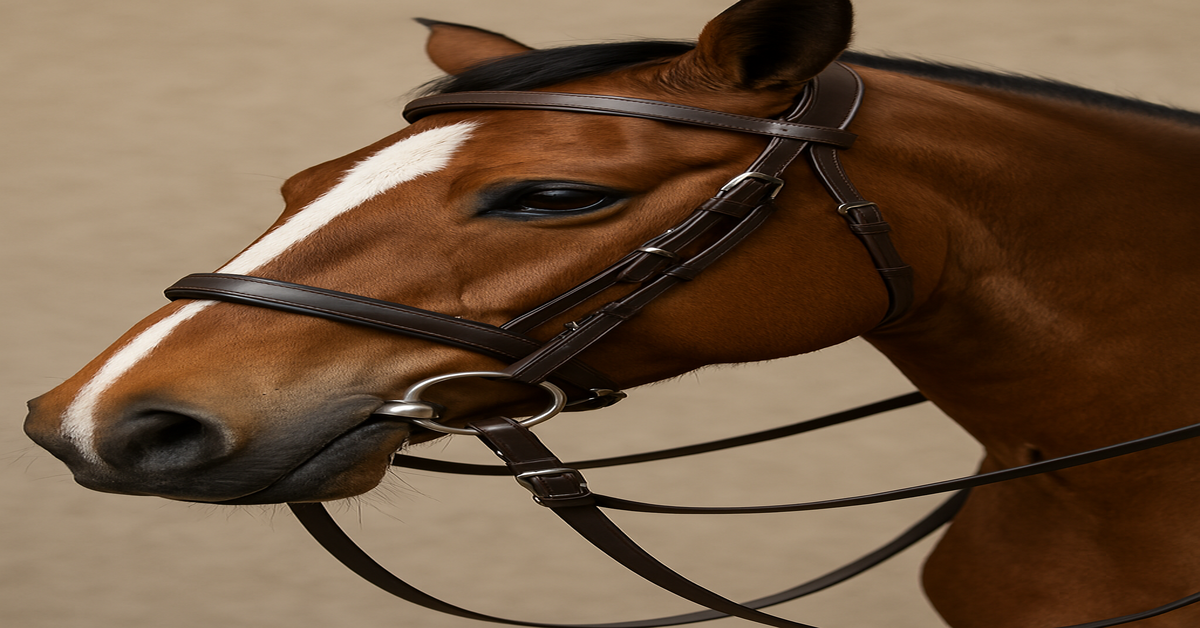Bridle have played a vital role in the relationship between humans and horses for thousands of years. This essential piece of tack enables communication and control while riding or driving a horse. Whether you’re a beginner learning to ride or a seasoned equestrian, understanding the bridle’s parts, types, functions, and history is essential.
In this comprehensive guide, we’ll explore everything there is to know about bridles—from their origin and construction to how to choose the right one for your horse. We’ll also delve into how to maintain and fit a bridle correctly for both comfort and safety.
The History and Evolution of the Bridle
Ancient Origins of the Bridle
Bridles date back over 3,000 years and were used in ancient civilizations such as Mesopotamia, Egypt, and China. Early bridles were often rudimentary, made from rawhide, rope, or sinew. Despite their simplicity, they revolutionized human interaction with horses by allowing control during transport, farming, and warfare.
Development Through the Ages
During the Classical and Medieval eras, bridles became more refined. Greek and Roman civilizations introduced metal bits, often decorated, and leather became the primary material for straps. In the Middle Ages, knights used elaborate bridles with ornate metalwork and heavy curb bits for their warhorses.
By the Renaissance, equitation became an art, especially in places like Italy and Spain. Bridles evolved accordingly, with baroque styles that balanced function and aesthetics. As horseback riding transitioned from necessity to sport and leisure in modern times, bridle designs diversified significantly.
What Is a Bridle?
Basic Definition
A bridle is a piece of headgear used to direct a horse. It typically consists of several straps fitted around the horse’s head and is used in conjunction with a bit and reins. The bridle allows the rider to guide, stop, and communicate with the horse using hand cues.
Main Components of a Bridle
- Headpiece (Crownpiece): The strap that goes over the top of the horse’s head, behind the ears.
- Browband: Runs across the forehead to keep the bridle from slipping back.
- Cheekpieces: Connect the bit to the headpiece.
- Noseband (Cavesson): Encircles the nose and jaw to help stabilize the bit and control the horse’s mouth.
- Throatlatch: Runs under the throat to keep the bridle in place.
- Reins: Attached to the bit, they allow the rider to control the horse’s direction and speed.
- Bit: A metal or synthetic device placed in the horse’s mouth to aid communication.
Types of Bridles
English Bridles
Snaffle Bridle
This is the most common type of English bridle, typically used in dressage, jumping, and general riding. It uses a simple bit and a single set of reins.
Double Bridle
Used primarily in advanced dressage and by high-level riders, this bridle incorporates two bits (a snaffle and a curb) and two sets of reins for finer control.
Figure-Eight (Grackle) Bridle
Designed to keep the horse’s mouth closed and prevent crossing the jaw, this bridle is often used in eventing and show jumping.
Drop Noseband Bridle
Places the noseband lower on the horse’s face. It helps prevent the horse from opening its mouth but is less common in modern use.
Western Bridles
One-Ear and Two-Ear Bridles
Common in Western disciplines, these bridles often lack a noseband and can have one or two loops over the ears. They offer a sleek design and minimal contact.
Split-Ear Bridle
A variation where one strap goes over the ear, and the other splits to lie beside it. Preferred by some riders for its aesthetic and simplicity.
Bosal and Hackamore
Western bridles can also be bitless, using a bosal (a type of noseband) to communicate with the horse. Hackamores apply pressure to the nose and jaw rather than the mouth.
Bitless Bridles
Ideal for horses with mouth sensitivity or riders following natural horsemanship. They apply pressure to the nose, poll, or chin instead of using a bit.
- Sidepull: Direct rein pressure applied to the side of the horse’s face.
- Cross-under: Uses straps that apply pressure behind the jaw.
- Mechanical Hackamore: Combines nose and poll pressure using metal shanks for leverage.
Choosing the Right Bridle for Your Horse
Factors to Consider
- Discipline: The type of riding (dressage, jumping, trail, Western, etc.) often determines bridle choice.
- Horse’s Mouth Conformation: Sensitive-mouthed horses may benefit from padded or bitless bridles.
- Rider Skill Level: Beginners may prefer simple snaffle bridles for ease of use.
- Horse Behavior: Horses prone to resisting the bit may require specialized nosebands or different bit types.
Sizing and Fit
Bridles come in various sizes (pony, cob, full, warmblood), but adjustments are essential for a proper fit:
- The browband should sit flat across the forehead without pinching.
- The noseband should rest 1–2 inches below the cheekbone.
- The bit should create a gentle wrinkle at the corners of the mouth.
- You should be able to fit two fingers under the throatlatch and noseband.
How to Fit and Adjust a Bridle
Step-by-Step Fitting Guide
- Place the Bridle Gently: Slide the headpiece over the horse’s ears.
- Adjust the Browband: Ensure it lies flat and doesn’t pull the headpiece forward.
- Position the Noseband: Align it properly and fasten snugly but not tightly.
- Secure the Throatlatch: Should be firm but allow movement and breathing.
- Check the Bit Position: Should sit evenly and comfortably in the mouth.
- Attach the Reins: Make sure they’re the correct length and not twisted.
Maintenance and Care of Bridles
Cleaning Tips
- Daily: Wipe down after each ride to remove sweat and dirt.
- Weekly: Deep clean using saddle soap and condition the leather.
- Monthly: Check for wear and tear, replace worn parts.
Storage
Store bridles in a dry, clean, cool area. Use a bridle hook or hanger to avoid warping or bending the leather.
Issues and Fixes
- Pinching or Rubbing: Adjust the fit or use padding.
- Horse Tosses Head: May indicate discomfort or dental issues.
- Bit Rejection: Try different bits or go bitless.
- Slipping Bridle: Tighten the throatlatch or ensure correct size.
Bridle Accessories and Enhancements
Add-ons for Comfort and Functionality
- Bit Guards: Prevent bit pinching.
- Flash Straps: Additional strap on the noseband for extra control.
- Padding and Gel Inserts: Improve comfort, especially for sensitive horses.
- Decorative Browbands: Aesthetic flair for shows or parades.
Bridles in Competition and Culture
Dress Code and Rules
Different equestrian disciplines have strict regulations about bridles. For example:
- Dressage: Only certain nosebands and bits allowed.
- Show Jumping: More flexibility in bit and bridle choice.
- Western Pleasure: Often mandates minimalistic bridles and no nosebands.
Cultural and Historical Significance
Bridles have also held ceremonial importance in various cultures—from Arabian horse shows to royal parades in Europe. Ornate bridles with silver, beadwork, or traditional patterns often symbolize status, celebration, or heritage.
The Future of Bridles
Technological Innovations
Modern bridles incorporate new materials like biothane, synthetic leather, and ergonomic designs. Some high-tech bridles even include pressure sensors to help trainers better understand rider-horse communication.
Ethical and Welfare Considerations
As the conversation around animal welfare grows, bitless bridles and more humane training methods are gaining popularity. Riders are increasingly choosing tack based on comfort and kindness rather than tradition alone.
Conclusion
Bridles are more than just functional gear—they are a fundamental part of horse riding history, communication, and culture. Whether you’re riding in an arena, exploring trails, or competing in shows, the right bridle can enhance your connection with your horse and improve performance. By understanding how bridles work, choosing the right type, ensuring proper fit, and maintaining them well, you set both yourself and your horse up for success.
FAQs
1. What is the difference between a bridle and a halter?
A bridle is used for riding and includes a bit and reins, allowing for control and communication. A halter is used for leading or tying a horse and doesn’t include a bit or reins.
2. Can you ride a horse without a bridle?
Yes, you can ride a horse without a bridle using a bitless option like a hackamore, rope halter, or riding with a neck rope, though this requires training and trust.
3. How often should I clean my horse’s bridle?
Ideally, wipe it down after every ride and deep clean weekly. Regular maintenance ensures comfort for the horse and longevity of the tack.
4. Is a bitless bridle better for my horse?
It depends on the horse. Some respond better to bitless options, especially if they have dental issues or are sensitive in the mouth. It’s important to try different methods and consult with a trainer.
5. What size bridle should I get for my horse?
Bridles come in sizes like pony, cob, full, and oversize. Measure your horse’s head or try on different sizes to ensure a comfortable and correct fit.
6. Can a poorly fitted bridle hurt my horse?
Absolutely. A poorly fitted bridle can cause pain, sores, behavioral issues, or even long-term damage. Always ensure your bridle fits properly and check it regularly for signs of wear or discomfort.











